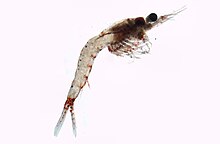Mysida
| Mysida | |
|---|---|
 |
|
| Hemimysis anomala (Mysidae) | |
| Scientific classification | |
| Kingdom: | Animalia |
| Phylum: | Arthropoda |
| Subphylum: | Crustacea |
| Class: | Malacostraca |
| Subclass: | Eumalacostraca |
| Superorder: | Peracarida |
| Order: |
Mysida Haworth, 1825 |
| Families | |
Mysida is an order of small, shrimp-like crustaceans in the malacostracan superorder Peracarida. Their common name opossum shrimps stems from the presence of a brood pouch or "marsupium" in females. The fact that the larvae are reared in this pouch and are not free-swimming characterises the order. The mysid's head bears a pair of stalked eyes and two pairs of antennae. The thorax consists of eight segments each bearing branching limbs, the whole concealed beneath a protective carapace and the abdomen has six segments and usually further small limbs.
Mysids are found throughout the world in both shallow and deep marine waters where they can be benthic or pelagic, but they are also important in some fresh water and brackish ecosystems. Many benthic species make daily vertical migrations into higher parts of the water column. Mysids are filter feeders, omnivores that feed on algae, detritus and zooplankton. Some mysids are cultured in the laboratory for experimental purposes and are used as a food source for other cultured marine organisms. They are sensitive to water pollution, so are sometimes used as bioindicators to monitor water quality.
...
Wikipedia
